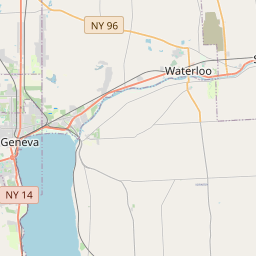Inscription
The landscape in front of you looked vastly different in Elizabeth Cady Stanton's day. Instead of a serene lake, mills and factories lined the much narrower Seneca-Cayuga Canal and Seneca River. Canal boats plied the waterways; trains on the Auburn-to-Rochester railroad chugged along the opposite bluff.
When Stanton and her family traveled into town on the Seneca Turnpike, they joined herds of animals, coaches, and laden wagons-all of them kicking up choking clouds of dust.
The view of the industries hugging the canal, the Seneca River, and the Seneca Turnpike so familiar to Stanton disappeared under Van Cleef Lake in the 1915 upgrade of the canal system.
[Illustration caption reads]
Stanton's view of Seneca Falls to the west, c.1840.
——————————————————
Women's Rights National Historical Park
Welcome to one of the few national parks dedicated to a social reform movement-women's rights.
Here in Seneca Falls and Waterloo, in living rooms and on front porches, in private and public, a group of five women started a movement that would transform American society.
In 1848, those five women summoned reformers from across the northeast to the Wesleyan Chapel in Seneca Falls. For
two days, as many as 300 women and men considered the role of women in a democratic society. They emerged with the Declaration of Sentiments-a document that shaped a reform movement for decades to come. Indeed, it continues today.
Women's Rights National Historical Park includes the Wesleyan Chapel and the homes of some of the movement's organizers-places where radical thought turned into enduring improvement for millions across the world.
When Stanton and her family traveled into town on the Seneca Turnpike, they joined herds of animals, coaches, and laden wagons-all of them kicking up choking clouds of dust.
The view of the industries hugging the canal, the Seneca River, and the Seneca Turnpike so familiar to Stanton disappeared under Van Cleef Lake in the 1915 upgrade of the canal system.
[Illustration caption reads]
Stanton's view of Seneca Falls to the west, c.1840.
——————————————————
Women's Rights National Historical Park
Welcome to one of the few national parks dedicated to a social reform movement-women's rights.
Here in Seneca Falls and Waterloo, in living rooms and on front porches, in private and public, a group of five women started a movement that would transform American society.
In 1848, those five women summoned reformers from across the northeast to the Wesleyan Chapel in Seneca Falls. For
two days, as many as 300 women and men considered the role of women in a democratic society. They emerged with the Declaration of Sentiments-a document that shaped a reform movement for decades to come. Indeed, it continues today.
Women's Rights National Historical Park includes the Wesleyan Chapel and the homes of some of the movement's organizers-places where radical thought turned into enduring improvement for millions across the world.
Details
| HM Number | HM1Z94 |
|---|---|
| Tags | |
| Marker Condition | No reports yet |
| Date Added | Thursday, June 29th, 2017 at 6:01pm PDT -07:00 |
Pictures
Locationbig map












| UTM (WGS84 Datum) | 18T E 354060 N 4752741 |
|---|---|
| Decimal Degrees | 42.91333333, -76.78795000 |
| Degrees and Decimal Minutes | N 42° 54.8', W 76° 47.277' |
| Degrees, Minutes and Seconds | 42° 54' 48" N, 76° 47' 16.62" W |
| Driving Directions | Google Maps |
| Area Code(s) | 315 |
| Which side of the road? | Marker is on the right when traveling West |
| Closest Postal Address | At or near 9 Seneca St, Seneca Falls NY 13148, US |
| Alternative Maps | Google Maps, MapQuest, Bing Maps, Yahoo Maps, MSR Maps, OpenCycleMap, MyTopo Maps, OpenStreetMap |
Is this marker missing? Are the coordinates wrong? Do you have additional information that you would like to share with us? If so, check in.
Nearby Markersshow on map
Show me all markers in: Seneca Falls, NY | Seneca County | 13148 | New York | United States of America
Maintenance Issues
- Is this marker part of a series?
- What historical period does the marker represent?
- What historical place does the marker represent?
- What type of marker is it?
- What class is the marker?
- What style is the marker?
- Does the marker have a number?
- What year was the marker erected?
- Who or what organization placed the marker?
- This marker needs at least one picture.
- Can this marker be seen from the road?
- Is the marker in the median?

Comments 0 comments